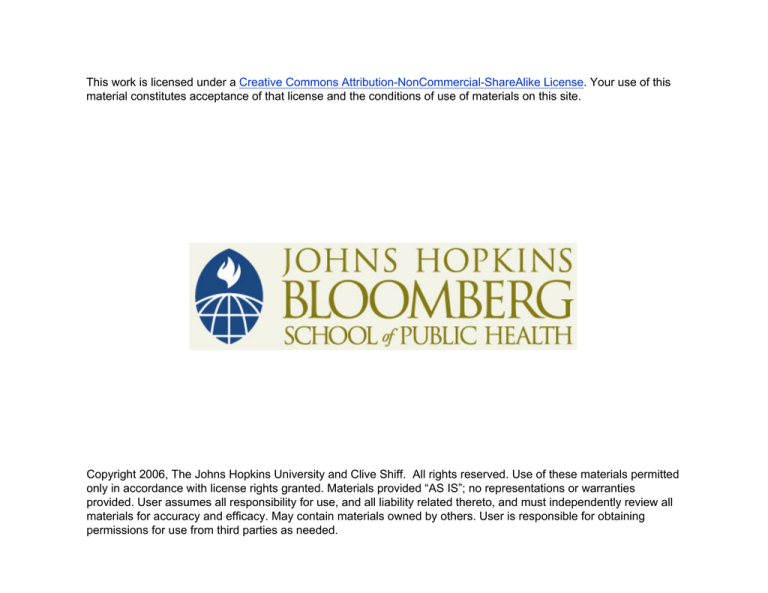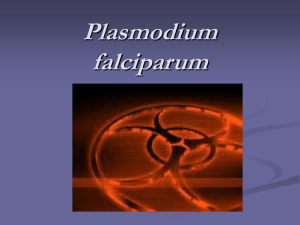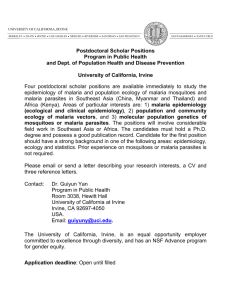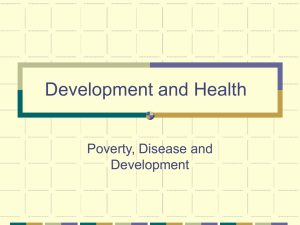
This work is licensed under a Creative Commons Attribution-NonCommercial-ShareAlike License. Your use of this
material constitutes acceptance of that license and the conditions of use of materials on this site.
Copyright 2006, The Johns Hopkins University and Clive Shiff. All rights reserved. Use of these materials permitted
only in accordance with license rights granted. Materials provided “AS IS”; no representations or warranties
provided. User assumes all responsibility for use, and all liability related thereto, and must independently review all
materials for accuracy and efficacy. May contain materials owned by others. User is responsible for obtaining
permissions for use from third parties as needed.
Malaria Control
Clive Shiff, PhD
“Malaria control depends on the presence of
essential public health functions. Health
services in tropical malarious countries have
not yet developed a public health capacity
adequate for the control of malaria. To
control malaria under current conditions
requires an international response,one that
builds national public health capacities
capable of fully supporting local initiatives.”
- Socrates Litsios: 2001: WHO. In “Malaria Control and the
future of International Public Health”
What is Malaria Control?
Mortality Control….? If this is the emphasis then it
will be based on treatment: Pros and Cons……!
¾What infrastructure is needed?
¾Diagnostic Services? Are these necessary?
¾Where will services be offered? Home? Clinic?
Hospital?
¾What strategy? Drug?
Malaria Morbidity Control
¾ Accepts that mortality is not the only problem
¾ Serious economic and social burden is associated
with malaria
¾ Strategies: Indoor spraying, insecticide-treated bed
nets, larviciding, environmental management,
prophylaxis, treatment during pregnancy, and improved
housing and screening,
¾Transmission Control?
Vector Control Objectives
¾ Reduce vector mosquito population
¾ Repel the vector mosquitoes
¾ Form a barrier between vector and potential host
(personal protection)
¾ Reduce the lifespan of vector mosquitoes
¾ Reduce the lifespan of potentially infected vector
mosquitoes
Eradication Strategy
¾Geographical reconnaissance
¾Attack Phase: Vector control until parasite
rate is low.
¾Surveillance Phase: Active case detection
programs continue until parasites
undetectable. ? Antigametocyte drugs
¾Maintenance Phase: Passive case detection
and effective treatment.
Malaria Control Strategy
Tactical Varient 1
chemotherapy
mortality reduction
Tactical Varient 2
mortality and morbidity
Tactical Varient 3
reduce prevalence
haphazard vector
control
Tactical Varient 4
Country Wide Control
Vector Control
Chemotherapy
Photo: Clive Shiff
Small pools in the sunlight: breeding sites for An.
gambiae and An. arabiensis
% of An.
g a m b ia e b itin g
Nocturnal Periodicity
25
20
15
10
5
0
18
19
20
21
22
23
24
Hours
1
2
3
4
5
6
Zanzibar Malaria Control 1957-1968
¾Control programmes commenced in 1958
¾Vector Control commenced with dieldrin in
1959
¾After 2 cycles parasite rate declined from
47% (Ingunja) to 1.0%. Pemba: 58%;
declined to 1.7%
¾Maintained until programme terminated in
1968. Resurgence occurred by 1973.
Seasonal Incursions of Malaria
(and Vectors) in Zimbabwe
Over winter in low veld < 600 m
Spring, warmer conditions in higher
ground: mosquitoes spread
Summer, rainy season, mosquitoes
spread and malaria occurs in
unstable conditions
Advantages of mosquito nets with insecticides
Hungry mosquitoes do not
wait in the room, they are
either killed or repelled
after contact with the net.
Mosquitoes die or escape
after landing on the net.
Mosquitoes fail to find
holes or other small
opening to enter.
A person sleeping in the
same room without a net
also receives some
protection
Fevers Called Homa
Homa za Shetani
Routine fevers
Unusual Fevers
Homa za Matatizo
Homa not for hospital
Homa za Vipindi
Boiling hot fever
Homa za Kawaida
Homa za Malaria
Homa za Vidonda
Malaria Cases – South Africa
1971
1973
1975
1977
1979
1981
1983
1985
1987
1989
1991
1993
1995
1997
1999
2001
70000
60000
50000
40000
30000
20000
10000
0
Eco-Epidemiological Zones
¾ African savannah malaria: holoendemic or
mesoendemic
¾ Fringe malaria (Africa), desert or highland
unstable, seasonal or periodic
¾ Global plains and valleys: various vectors, various
breeding sites
¾ Forest related malaria
¾ Urban malaria
¾ War and refugee malaria
Urban Malaria Control
¾Mapping to identify mosquito breeding sites
¾Aerial photography to determine problem
areas
¾Identification of breeding sites
¾Environmental management, drainage and
application of bye-laws
Integrated VECTOR Management…?
¾A new term that is appearing to “integrate” into
malaria control
¾Appears to follow “integrated pest management
BUT..?
¾ There are no parasites or predators to attack mosquito
populations.
¾ The concept is vague and there are few scientific data
¾ Techniques include habitat modification to reduce mosquito
breeding… again little evidence against most vector species
¾ Sounds compatible with ecological principles, and is
supported by USAID and WHO. But how…?
Integrated Vector Management
¾Reduction of breeding sites?
¾Draining swamps and flooded areas
¾Use of fish to eat mosquito larvae
¾Grass cutting and detritus removal
¾Peridomestic source removal (spade work!)
¾Problem of nuisance mosquitoes






